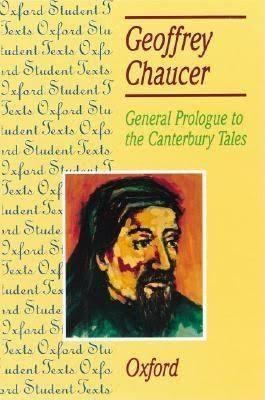Followed by The Knight's Tale | ||
 | ||
Similar Geoffrey Chaucer books, The Canterbury Tales books, Other books | ||
The general prologue
Synopsis
The frame story of the poem, as set out in the 858 lines of Middle English which make up the General Prologue, is of a religious pilgrimage. The narrator, Geoffrey Chaucer, is in The Tabard Inn in Southwark, where he meets a group of "sundry folk" who are all on the way to Canterbury, the site of the shrine of Saint Thomas Becket.
The setting is April, and the prologue starts by singing the praises of that month whose rains and warm western wind restore life and fertility to the earth and its inhabitants. This abundance of life, the narrator says, prompts people to go on pilgrimages; in England, the goal of such pilgrimages is the shrine of Thomas Becket. The narrator falls in with a group of pilgrims, and the largest part of the prologue is taken up by a description of them; Chaucer seeks to describe their 'condition', their 'array', and their social 'degree':
To telle yow al the condicioun,Of ech of hem, so as it semed me,And whiche they weren, and of what degree,And eek in what array that they were inne,And at a knyght than wol I first bigynne.The pilgrims include a knight, his son a squire, the knight's yeoman, a prioress accompanied by a second nun and the nun's priest, a monk, a friar, a merchant, a clerk, a sergeant of law, a franklin, a haberdasher, a carpenter, a weaver, a dyer, a tapestry weaver, a cook, a shipman, a doctor of physic, a wife of Bath, a parson, his brother a plowman, a miller, a manciple, a reeve, a summoner, a pardoner, the host (a man called Harry Bailly), and a portrait of Chaucer himself. At the end of the section, the Host proposes the story-telling contest: each pilgrim will tell two stories on the way to Canterbury and two on the way back. Whoever tells the best story, with "the best sentence and moost solaas" (line 798) is to be given a free meal.
The Tales
Structure
The General Prologue establishes the frame for the Tales as a whole (or of the intended whole) and introduces the characters/story tellers. These are introduced in the order of their rank in accordance with the three medieval social estates (clergy, nobility, and commoners and peasantry). These characters, while seemingly realistically described, are also representative of their estates and models with which the others in the same estate can be compared and contrasted.
The structure of the General Prologue is also intimately linked with the narrative style of the tales. As the narrative voice has been under critical scrutiny for some time, so too has the identity of the narrator himself. Though fierce debate has taken place on both sides, (mostly contesting that the narrator either is, or is not, Geoffrey Chaucer) it should be noted that most contemporary scholars believe that the narrator is meant to be some degree of Chaucer himself. Some scholars, like William W. Lawrence, claim that the narrator is Geoffrey Chaucer in person. While others, like Marchette Chute for instance, contest that the narrator is instead a literary creation like the other pilgrims in the tales.
Manly attempted to identify pilgrims with real 14th century people. In some instances such as Summoner and Friar, he attempts localization to a small geographic area. The Man of Law is identified as Thomas Pynchbek (also Pynchbeck) who was chief baron of the exchequer. Sir John Bussy was an associate of Pynchbek. He is identified as the Franklin. The Pembroke estates near Baldeswelle supplied the portrait for the unnamed Reeve.
First 18 lines
The following is the first 18 lines of the General Prologue. The text was written in a dialect associated with London and spellings associated with the then-emergent Chancery Standard.
In modern prose:
When April with its sweet showers has pierced March's drought to the root, bathing every vein in such liquid by whose virtue the flower is engendered, and when Zephyrus with his sweet breath has also enlivened the tender plants in every wood and field, and the young sun is halfway through Aries, and small birds that sleep all night with an open eye make melodies (their hearts so goaded by Nature), then people long to go on pilgrimages, and palmers seek faraway shores and distant saints known in sundry lands, and especially they wend their way to Canterbury from every shire of England to seek the holy blessed martyr, who helped them when they were ill.
